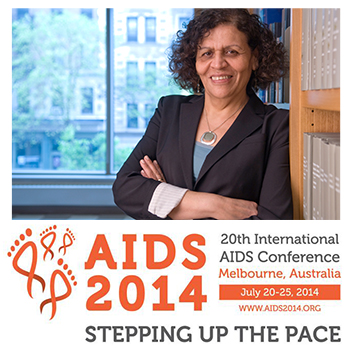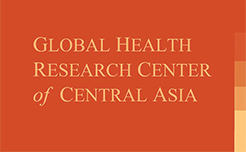Originally posted by the Columbia School of Social Work —Compiled and edited by ML Awanohara
 The Communications Office at the Columbia School of Social Work caught up with Nabila El-Bassel, the Willma and Albert Musher Professor of Social Work, just as she was preparing to leave for the International AIDS Society Conference, which is held every two years. She had a long journey ahead because this time the conference is being hosted in Melbourne, Australia. But fortunately she was able to take time out of her intense schedule to answer a few of our questions about her participation in the conference, as well as her work of the past 25 years in the field of AIDS intervention research.
The Communications Office at the Columbia School of Social Work caught up with Nabila El-Bassel, the Willma and Albert Musher Professor of Social Work, just as she was preparing to leave for the International AIDS Society Conference, which is held every two years. She had a long journey ahead because this time the conference is being hosted in Melbourne, Australia. But fortunately she was able to take time out of her intense schedule to answer a few of our questions about her participation in the conference, as well as her work of the past 25 years in the field of AIDS intervention research.
Thanks for agreeing to answer a few questions, Professor El-Bassel. Tell us, what is the theme of the 2014 AIDS Conference?
The theme is “Stepping up the Pace.” It refers to the critical juncture we AIDS researchers face in the global response to the AIDS pandemic. Recent data show a steady decrease in AIDS-related deaths and new HIV infections, as well as an increase in the number of people engaged in HIV treatment and care. In addition, we’ve seen substantial progress in vaccine research and in possible cures for this devastating syndrome, including Treatment as Prevention. Each of these advances has instilled a sense of optimism, but our challenge now is to build on that optimism on behalf of countries that are still struggling with a burgeoning epidemic as well as several key populations who remain vulnerable to the virus. We have to accelerate the pace of scaling up HIV prevention, treatment and services in low-resourced countries and for key affected populations: people who use drugs, women and girls, men who have sex with men, and transgender individuals. These populations face barriers to effective prevention and treatment, including stigma, discrimination, poverty, gender-based violence, denial of sexual health rights, and repressive policies.
We understand you are giving a talk entitled “People Who Inject Drugs in Intimate Relationships: It Takes Two to Combat HIV.” Can you tell us a little more about this?
My talk will focus on an innovative, evidence-based HIV intervention for women and men who use or inject drugs, which has been designed and tested at the Social Intervention Group (SIG) and the Global Health Research Center of Central Asia (GHRCCA), two centers I direct at the Columbia School of Social Work. I will present data from research I have conducted with colleagues Louisa Gilbert, Susan Witte, Elwin Wu and others on behavioral HIV prevention science. Specifically, the talk will cover:
- the global epidemiology of injection drug use and HIV among women in committed, intimate relationships.
- gender roles in intimate relationships in drug-using cultures (micro social contexts).
- the state of science on HIV prevention with couples.
- findings from two NIDA-funded studies on the efficacy of a couple-based prevention, which were conducted in the United States and in Kazakhstan to address the micro social contexts of unsafe injection and sexual practices among people who inject drugs.
“It takes two”
What do you mean by “It takes two to combat HIV”?
Typically, just the man or just the woman is treated rather than bringing both members of the couple together for treatment. But, according to our findings, several benefits occur when we design an intervention that brings female and male drug-using intimate partners together in a safe environment and encourage them to adopt strategies to protect themselves and each other from HIV, build a healthy relationship, and/or seek HIV treatment and care (if needed). Couples treated in this way tend to reduce their risky behaviors, lower their incidence of HIV and hepatitis C virus (HCV) transmission, and avoid drug overdoses. The key is to create a safe environment for couples to disclose sensitive issues such as sexual coercion, extra-dyadic relationships (sexual interactions with people outside of the relationship), gender power imbalances, and sexual risks. Our “it takes two” approach also supports the integration of HIV and reproductive health care, and makes it easier to identify and recruit others for treatment who may have been exposed to the virus.
How long have you been working in the field of HIV/AIDS intervention?
I, along with my colleagues at SIG and the GHRCCA, have been conducting HIV bio-behavioral research for 25 years. Most of our work has been focused on people who use or inject drugs and other key affected populations such as sex workers or men who have sex with men. We have conducted a number of epidemiological HIV studies to understand the link between HIV, drug use and intimate partner violence against women. Our studies employ both qualitative and quantitative methods, and have been conducted in drug treatment programs, homeless shelters, street-based venues, jails and probation sites, primary care facilities, emergency departments and related settings. We have published extensively on our findings and have used them to guide the design and implementation of HIV prevention models for women, in both the United States and globally.
Is couple-based research one of your unique contributions to the HIV intervention field?
We have conducted four large couple-based HIV clinical trials: three in the US and one in Kazakhstan. All three U.S. studies were identified as “best practices” by the Centers for Disease Control and Prevention (CDC) so are now being implemented in real world settings. Project Renaissance, a couple-based study that was completed recently in Kazakhstan, was also found to be efficacious and we expect it, too, will receive the CDC’s endorsement. We have also been involved in couple-based implementation studies to identify that factors that need to be present to implement an evidence-based, innovative HIV intervention in real-world settings with couples in New York City. More recently, under the leadership of Dr. Witte, we completed a study that implements the findings of Project Connect, a couple-based HIV intervention in 80 HIV agencies. We are proud that we have been able to design studies that make a difference in science as well as in people’s lives.
Future research agenda
What is your next research project?
We just completed three studies:
- Project WORTH, an HIV prevention study among women on probation who use drugs.
- Project WINGS, which tested the efficacy of a brief, self-paced computerized intervention to identify women on probation who have experienced partner violence and link them to services. It was led by Dr. Louisa Gilbert.
- Project Undarga, which tested the efficacy of combining micro-finance with HIV prevention among sex workers in Mongolia. It was led by Dr. Susan Witte.
Right now we are studying the implementation of a couple-based research with young men on probation and their female partners. We are also conducting a study among young African American men who have sex with men, which is being led by Dr. Wu.
What about internationally?
On the international front, we have HIV prevention and epidemiological studies on TB and other co-morbidities underway in Kazakhstan and other Central Asian countries, where the HIV epidemic is largely driven by the use of injection drugs.
How do you disseminate your research?
In 2013, investigators at SIG and GHRCCA published more than 30 peer review papers. We also produced a special issue of the international journal Drug and Alcohol Dependence, on HIV prevention in Central Asia. We brought in senior scientists from Central Asia, US and other countries as contributers. In addition to publications, we attend quite a few national and international conferences, like this one. And we sponsor seminars and workshops on various topics.
How do you reach audiences outside of academe?
We recently redeveloped the Web presence for both SIG and GHRCCA and are active on social media. In Central Asia and Mongolia, we rely on the staff who run GHRCCA’s field office, which is located in Almaty, Kazakhstan. Dr. Assel Terlikbayeva and her management team, Sholpan Primbetova and Buarzhan Zhussupov, and Aina Tovgoo in Mongolia, work very hard to get the word out about our findings to community healthcare providers as well as to policy makers.
Mentoring, collaboration and training
Do you involve students and other faculty, as well as research scientists, in your work?
Our Centers serve as a training lab for pre-docs and masters-level students (not only from CSSW but also from other Columbia schools). We provide field placements for both domestic and international MSW students. The students participate in the Centers’ activities and are considered as an integral part of our research team. In addition, we have a number of faculty from Columbia and other universities who collaborate with us on research activities, both in the US and internationally. We emphasize multidisciplinary collaboration and promote this approach in all of the Centers’ activities, an approach we find very exciting.
Can you give me any examples of collaboration with other Columbia schools?
Recently, we were funded by the National Institute of Drug Abuse (NIDA) for a project in collaboration with the Mailman School of Public Health (MSPH). It’s a T32 training program for a pre- and post-docs. Dr. Wu and I are working with Dr. Lisa Metsch, who chairs MSPH’s Department of Sociomedical Sciences, to create a solid multidisciplinary training program.
Which reminds us: We believe you are very active in training the next generation of researchers?
Yes, we have a mission to train and mentor the upcoming generation of HIV and drug abuse research scientists. We have been fortunate to be funded by National Institute of Mental Health (NIMH) since 2008 for a superb training program to achieve this goal. The program is called the HIV Intervention Science Training Program (HISTP) and is for underrepresented new investigators. On a yearly basis, we recruit 4–6 trainees from different part parts of the country to participate.
Thanks, Professor El-Bassel for taking the time to do this interview. It is impressive to hear about all the ways you and your team have been setting, as well as stepping up, the pace for AIDS intervention research. Our School and its students are lucky to have you!



Connect with us